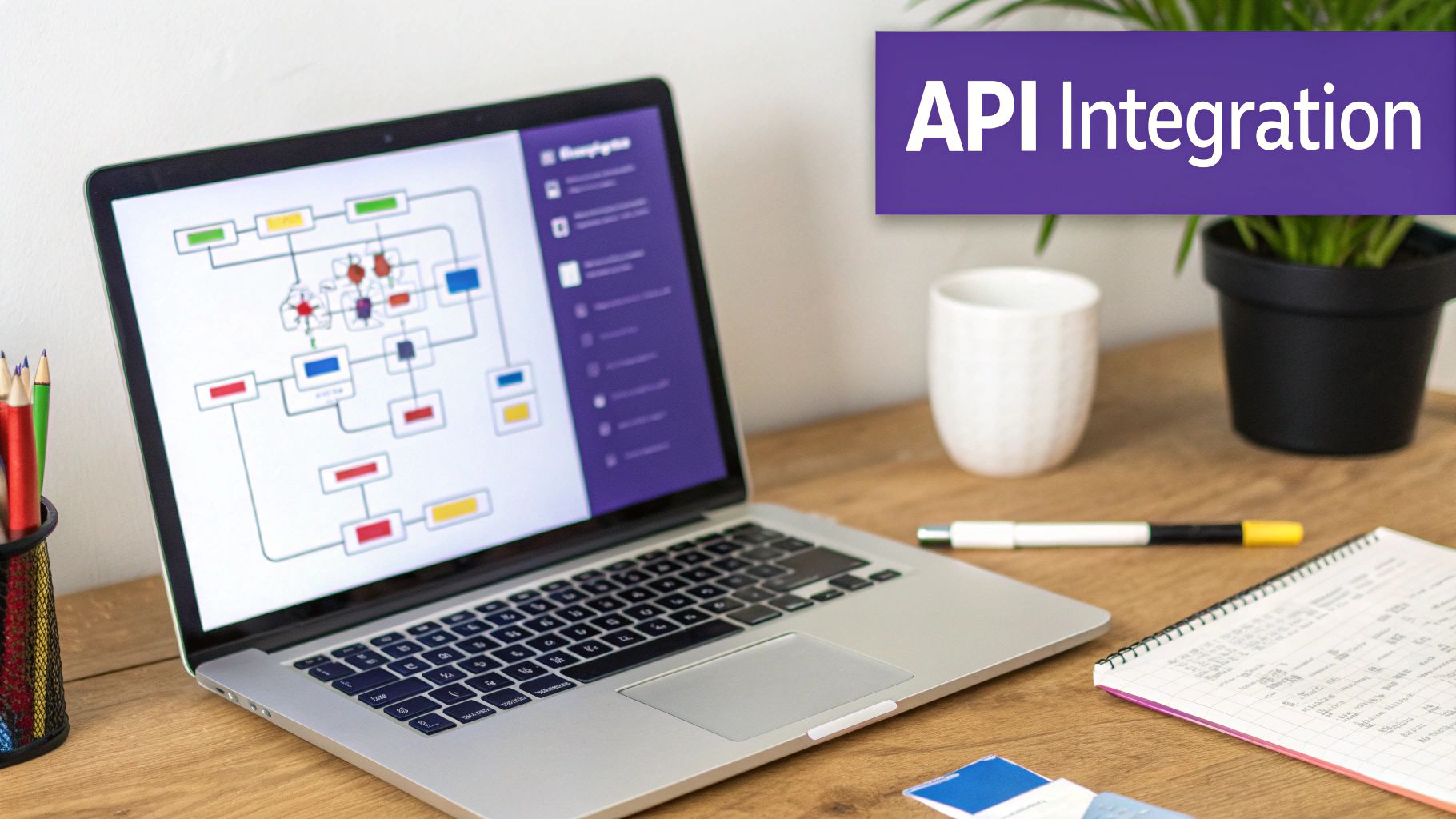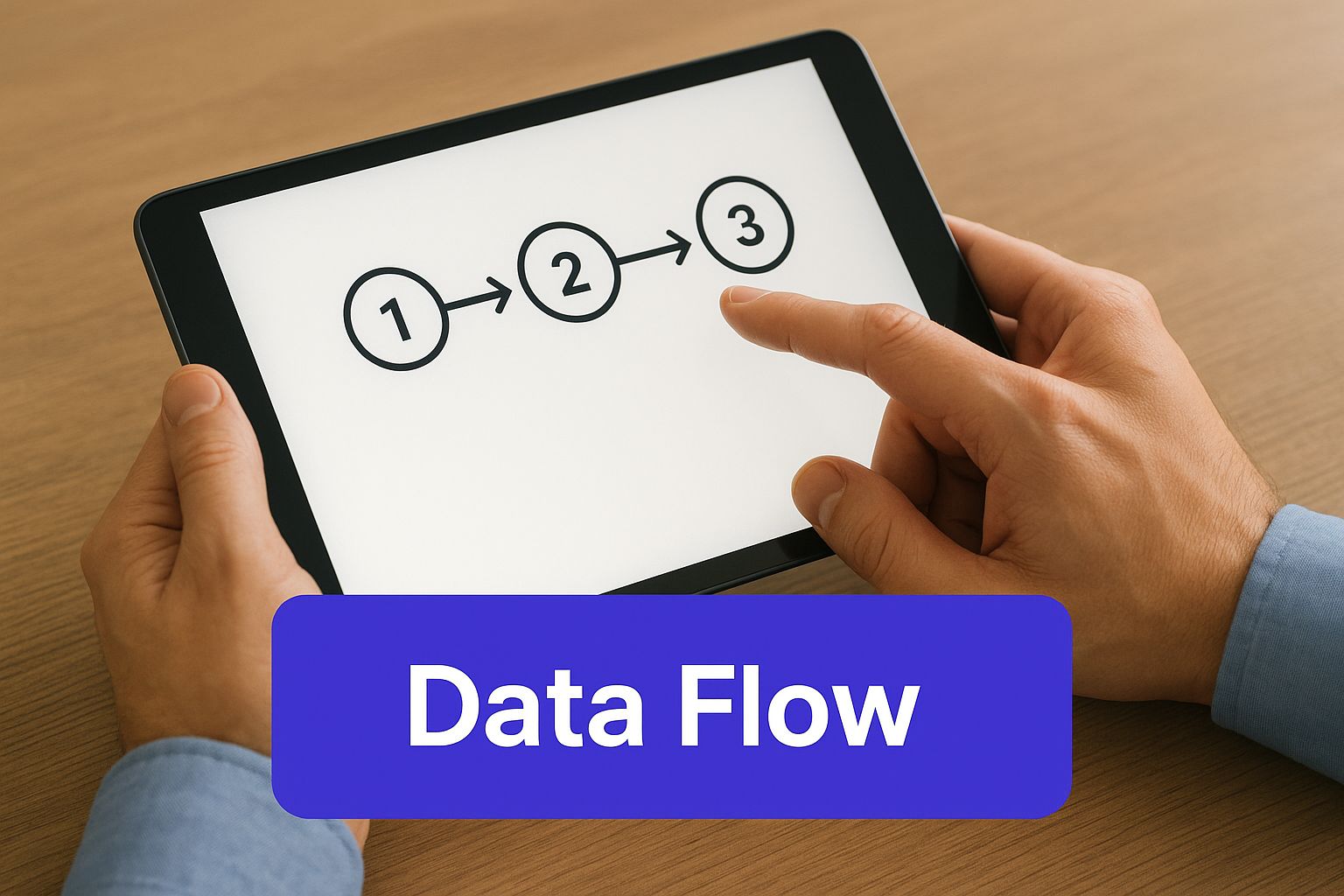What Is API Integration? Key Insights & Examples
What Is API Integration? Key Insights & Examples
API integration is the magic that happens behind the scenes, letting different software applications talk to each other and share information. Think of it as a digital handshake; it's the invisible connection that powers the apps you use every single day.
A perfect example is your weather app. It doesn't have its own weather station—instead, it pulls forecast data from a massive meteorological service. That connection is an API integration, and it allows businesses to build powerful, feature-rich tools without having to create every single component from scratch.
The Core Concept of API Integration

To really get your head around API integration, let's use a simple analogy. Picture yourself in a restaurant. You want to order food from the kitchen, but you don't just wander back there and start cooking. Instead, you look at a menu and give your order to a waiter.
In this scenario, it breaks down like this:
- You are one application (like your phone).
- The kitchen is the other application or server holding the data or service you need.
- The menu is the API (Application Programming Interface). It lists all the available options and the rules for making a request.
- The waiter is the integration itself, taking your request to the kitchen and bringing the food (data) back to your table.
That entire workflow—from you ordering to the food arriving—is the API integration. It's a structured conversation that lets one piece of software request something from another and get a predictable response. This is absolutely fundamental to how modern software works.
This model lets developers build much better applications, much faster. For instance, a UK-based Flutter developer can add a payment gateway like Stripe to a mobile app using its API. This is infinitely easier than trying to build a complex, secure payment processing system from the ground up.
The market reflects just how critical these connections have become. The UK's API market was valued at USD 1.5 billion and is on track to hit nearly USD 5.14 billion by 2035. If you're curious, you can dig deeper into these insights into the UK API market.
At its heart, API integration is about using specialised, pre-built tools to add powerful features to your own application. It boosts efficiency, speeds up development, and allows completely different systems to work together as one. This is how you create the seamless, connected experiences that users now expect.
How the API Request and Response Cycle Works
To really get what’s happening during an API integration, it helps to picture it as a simple, back-and-forth conversation. This whole process is basically a structured chat between two applications, making sure data gets exchanged securely and efficiently. One application, which we call the client, is the one that starts the conversation.
The client kicks things off by sending an API call. Think of this as a very specific request for either a piece of information or for an action to be performed. This call gets sent to an endpoint, which is just a unique address on the other application's server—much like sending a letter to a specific street address. For it to work, the request has to be formatted perfectly, following the API's own set of rules.
The Server's Role in Responding
Once the server gets the API call, it gets straight to work. First, it authenticates the request to make sure the client actually has permission to be asking for this stuff. After that’s sorted, the server processes the request, finds the information it needs or performs the action, and then wraps the result up into a neat, structured package.
This package is the response, which is then sent back to the client. The response might contain the data you asked for (like a list of products from an e-commerce site), or it could just be a simple confirmation that an action was completed successfully (like updating a customer's record). The incredible part? This entire cycle can happen in milliseconds.
This visual gives you a great idea of the constant flow of data between the two applications.

As the image shows, it’s this cycle of requests and responses that builds a seamless bridge for information to travel across.
Standardising the Conversation with REST
To keep all these digital conversations organised, developers often rely on a common set of architectural principles. One of the most popular is REST (Representational State Transfer). REST isn’t a rigid protocol but more of a flexible style guide that uses standard web methods everyone already understands.
You can think of it as a universal grammar for APIs:
- GET: This is for retrieving data, like asking a server for a user's profile information.
- POST: Used when you want to create something new, such as adding an item to an online shopping cart.
- PUT: This updates something that already exists—for instance, changing a delivery address.
- DELETE: Pretty straightforward; this is used to remove data.
By using these standard methods, REST APIs make it incredibly predictable for different systems to talk to each other. For developers building high-performance Flutter apps in the UK, that predictability is absolutely key to creating reliable and scalable integrations.
Unlock Business Growth with API Integration

Putting the technical jargon aside for a moment, the real magic of API integration is what it can do for your business. This isn't just about linking software together; it's about unlocking serious efficiencies, delighting your customers, and laying the groundwork for rapid expansion.
The most obvious win? Automation. Think about all the time wasted on tedious, manual data entry. By connecting systems that don't naturally speak the same language—like your CRM and your email marketing platform—you can say goodbye to that drudgery. This simple connection streamlines workflows, cuts down on human error, and frees up your team to focus on the bigger picture.
Improving Efficiency and User Experience
But enhanced efficiency is just the beginning. API integration is also the backbone of a modern, seamless user experience. When someone uses your app, they expect everything to just work.
Take a delivery app, for instance. Integrating a mapping API allows customers to track their driver's location in real-time. It seems simple, but that one feature, powered by an API, provides transparency and builds trust. It turns a standard service into an exceptional one, and that’s what keeps people coming back.
The core advantage of API integration is its ability to accelerate innovation. Instead of building every single feature from the ground up, you can stand on the shoulders of giants by plugging in existing, battle-tested services.
This approach lets you scale your operations much, much faster. When you're building a new product, developers can add complex features like payment processing or user authentication in a fraction of the time it would take to build them from scratch. This agility is vital for keeping up with market changes and staying one step ahead of the competition.
If you're curious about how this fits into the broader picture, our guide on app development in the UK from concept to launch provides some great insights.
As Flutter app developers, we see firsthand how crucial a high-performance framework is for creating apps that can handle these complex integrations smoothly. New benchmarks consistently show that Flutter is a top performer, making it an excellent choice for building sophisticated, API-driven applications.
Real-World Examples of API Integration You Use Daily
API integration isn’t some far-off, techy concept locked away in a server room. It's actually the invisible glue holding together the digital experiences you use every single day. The moment you understand what you're looking for, you'll realise the answer to "what is API integration?" is right there on your phone screen.
These connections are happening constantly behind the scenes, making your life simpler. You'll find them when you’re shopping online, booking a holiday, or even just logging into an app. Each one of those simple actions relies on different systems talking to each other seamlessly, all thanks to APIs.
Secure Payments and E-commerce
When you buy something from an online shop, you probably don’t think twice about how your payment is processed. The reality is, that retailer hasn't built its own global, ultra-secure payment system from scratch. Why would they? Instead, they use a payment gateway API from a specialist like Stripe or PayPal.
This integration does all the heavy lifting. It securely handles the complex, sensitive work of authorising your card and moving the money. The e-commerce site simply sends an API request to the payment service, which then replies to say whether the transaction was successful. This frees up businesses to focus on what they do best—their products—instead of trying to become a bank.
Payment APIs are now the backbone of UK commerce. The country processed a staggering 48.1 billion payments in just one year. With 87% of UK adults now using online banking, the demand for instant, secure transactions is non-negotiable. These integrations are what make handling that enormous volume possible. You can dig into more data on the importance of UK payment APIs if you’re curious.
Aggregating Data for Travel
Think about the last time you used a travel comparison site to find a flight or hotel. That site doesn't own a single plane or hotel room. So how does it have all that information? It uses API integration to pull real-time data from hundreds of different airlines, hotel chains, and booking systems.
When you type in your dates and destination, the website fires off a flurry of API calls simultaneously. It then collects all the responses—prices, availability, and timings—and neatly presents them to you in one organised list. This is a brilliant use of APIs that turns what would be an incredibly tedious task into a simple, two-minute search.
Simplifying Logins with Social Sign-On
You’ve definitely seen those "Log in with Google" or "Continue with Facebook" buttons. That convenient little feature is another perfect, everyday example of API integration.
Instead of forcing you to create another username and password you’ll just forget, the app uses an existing account to prove you are who you say you are. This is how it works under the hood:
- You click the "Log in with Google" button.
- The application sends a quick API request over to Google, asking for identity verification.
- Google checks it's you (often without you even needing to re-enter a password) and sends a secure, one-time token back to the app.
- The app receives the token, confirms it's valid, and you're logged in. Simple as that.
This process isn't just more convenient for you; it's also a big security win. The application never has to handle or store your password, massively reducing the risk of your data being compromised if they ever get hacked.
To give you a better sense of how APIs pop up in different industries, we've put together a quick summary of some of the most common applications.
| Use Case | Example Service | Functionality Enabled |
|---|---|---|
| Social Media Sharing | Buffer, Hootsuite | Post content to multiple platforms (Facebook, X, LinkedIn) from one dashboard. |
| Location & Mapping | Uber, Deliveroo | Embed Google Maps to show real-time driver locations, calculate routes, and estimate arrival times. |
| Internal Systems Sync | HubSpot + Salesforce | Automatically sync customer data between a marketing platform (HubSpot) and a CRM (Salesforce). |
| Communication | Twilio | Enable apps to send automated SMS notifications, alerts, and verification codes to users. |
| Cloud Storage | Dropbox, Google Drive | Allow applications to save, access, and manage files directly within a user's cloud storage account. |
As you can see, APIs are the crucial connectors that allow specialised services to work together, creating the powerful and convenient digital tools we rely on.
Choosing the Right Framework for High-Performance Apps
When you're building an app that relies heavily on pulling in data from multiple sources, your choice of development framework is a make-or-break decision. It's the engine under the bonnet. The right one ensures your app can fetch, process, and show information smoothly, which is the bedrock of a good user experience. A poor choice? Expect sluggish performance and frustrated users.
As a UK-based development team, we've seen first-hand how crucial a high-performance, cross-platform solution is. This is exactly where a framework like Flutter comes into its own. It lets our developers write code once that works flawlessly on both iOS and Android. This single codebase approach drastically simplifies building and maintaining apps that are constantly talking to APIs, making it easier to deliver a slick, consistent experience on any device.
Why Flutter is a Powerhouse for API Integration
Performance simply can't be an afterthought when your app is juggling multiple API connections. Time and again, new benchmarks show Flutter leading the pack, proving it can handle data-heavy tasks and complex API calls with impressive speed. Its entire architecture is built for high-performance rendering, which means the user interface stays buttery smooth, even when it's fetching heaps of data in the background.
For any business wanting a scalable and efficient mobile app, how well the framework manages API calls is paramount. Flutter’s performance gives it a clear edge, making it a fantastic choice for building robust apps that can grow with your business.
Getting the technology right from the start is how you avoid performance headaches later on. To really grasp how different frameworks stack up, especially for apps built around solid API integration, it helps to look at their core strengths. If you're currently weighing up your options, taking a look at a detailed comparison of Flutter vs React Native can offer some real clarity on the best path for your project.
Navigating Common Challenges and Security Risks
While API integration is a game-changer, it’s not without its hurdles. You need a solid strategy to navigate the common bumps in the road. For instance, what happens when a service you rely on updates its API? Your connection could suddenly break, throwing a spanner in the works. This is a classic versioning headache.
Then there's the challenge of keeping your data consistent. When information is flying between two or more systems, you have to be certain it stays accurate and up-to-date everywhere. Without careful planning, these operational hiccups can cause real problems.
But for any UK business, the biggest concern has to be security. When you open a channel for data to flow between applications, you're essentially creating a doorway. And you need to make sure that doorway is properly guarded. The most common threats are exactly what you'd expect: unauthorised data access and malicious attacks looking for any weakness to exploit.
Fortifying Your API Connections
Protecting your company and customer data is simply non-negotiable. It’s a massive area of concern for UK organisations, and for good reason. Recent figures show the number of businesses hit by API security incidents shot up from 69% to 83%, mostly because of simple misconfigurations. You can get more insights on the evolving API landscape and its security concerns at IT Security Guru.
To get ahead of these risks, developers put a few essential security practices in place:
- Robust Authentication: Think of this as the bouncer on the door. It uses things like API keys or protocols like OAuth to check the ID of any application trying to make a request. Only legit apps get in.
- Proper Authorisation: Once an app is inside, authorisation acts like a VIP pass. It makes sure that even authenticated applications can only access the specific data they’re actually allowed to see.
- End-to-End Encryption: This scrambles the data while it's in transit. By using technologies like TLS, the information becomes unreadable to anyone who might try to intercept it between systems.
By understanding these challenges from the get-go and building in proven security measures from day one, you can create an integration strategy that's built to last. It’s all about being proactive to keep your digital assets safe.
This idea of baking security into your process is a core principle of modern, automated development. To see this in action, take a look at our guide on what continuous integration means for Flutter apps, where security checks become a natural part of every single development stage.
Your API Integration Questions Answered
When you first start looking into what API integration can do for your business, a few common questions always seem to pop up. Let's tackle them head-on with some straightforward answers to clear things up.
What Is the Difference Between an API and API Integration?
It’s easy to mix these two up, but the distinction is pretty simple.
Think of an API as a restaurant menu—it lays out all the options and rules for what you can order. API integration, on the other hand, is the entire process that follows. It's you placing the order, the waiter taking it to the kitchen, the chefs preparing your food, and the meal arriving at your table.
So, the API is the rulebook, and the integration is the action that makes it all happen.
Do I Need a Developer for API Integration?
For most business needs, the answer is a firm yes. While there are some "no-code" tools out there that can handle very basic connections, they often fall short when things get more complex.
A professional developer is crucial for managing the tricky parts like security, authentication, and custom data mapping correctly. Working with an expert Flutter team ensures your integration isn't just functional but also secure, scalable, and performs flawlessly on any device.
Ready to build a powerful, seamlessly connected app for your business? The team at App Developer UK specialises in creating high-performance Flutter applications driven by robust API integration. Start your project with us today.